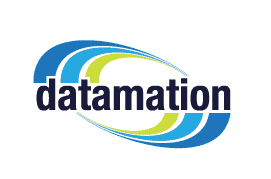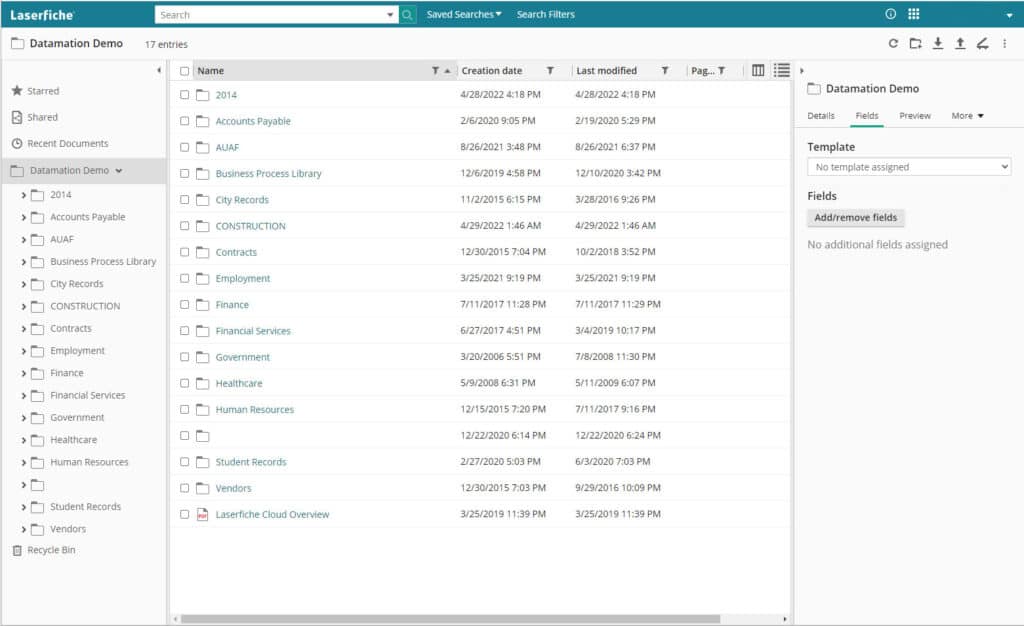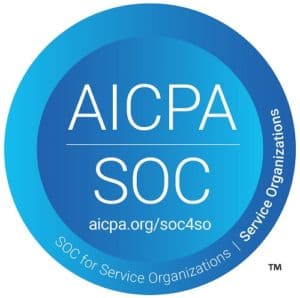A couple of years ago, software reviewer Gartner proclaimed that enterprise content management, as a term, was dead. Instead, they repackaged and expanded the concept into a term called “Content Services.”
Even though the proclamation happened a few years ago, the term really hasn’t caught on. The general public – and the industry – still widely calls it document management software or enterprise content management.
 Here on the Datamation blog we’ve talked about the difference between document management and enterprise content management. So what’s the deal with content services?
Here on the Datamation blog we’ve talked about the difference between document management and enterprise content management. So what’s the deal with content services?
We cover a lot about content services in this blog post, so here are quick links if you wanted to jump to a particular section:
- What are Content Services?
- What is the Difference between Content Services and ECM?
- What is a Content Services Platform?
- What Are the Different Elements of Content Services?
- Why Do I Need a Content Services Platform?
- What Should I Consider When Shopping for a Content Services Platform?
What are Content Services?
Content Services is a term used to describe the entire ecosystem of your company’s information. This can include document management systems, workflow, application programming interfaces (APIs) and integrations, web-based tools and platforms, and anything used to help your information move smarter and your employees be more productive.
What is the Difference between Content Services and ECM?
The idea of an enterprise content management system was that this one system would be the go-to source for all content in the company. However, this rarely happened in practice. Invoices would be created in one location, employee information was stored elsewhere, and there were many legacy systems that needed specialized integrations.
ECM was envisioned as a “closed” environment that would handle all information needs. Content services promotes openness and connectivity among multiple repositories and systems.
In practice, you’ll likely hear people use ECM and Content Services interchangeably. But for specific definitions:
Document management system (DMS) refers specifically to how you store and access your documents, along with monitoring the lifecycle of those documents.
Enterprise content management (ECM) is how every single piece of information in your business is used. This includes strategies and tools like workflow that are programed to send your information to the person who needs it.
Content services (CS) is very similar in definition to ECM, but recognizes that real-life, practical applications are likely not done out of one centralized platform. Content services also includes integrations and APIs to seamlessly connect databases, repositories, and workflows.
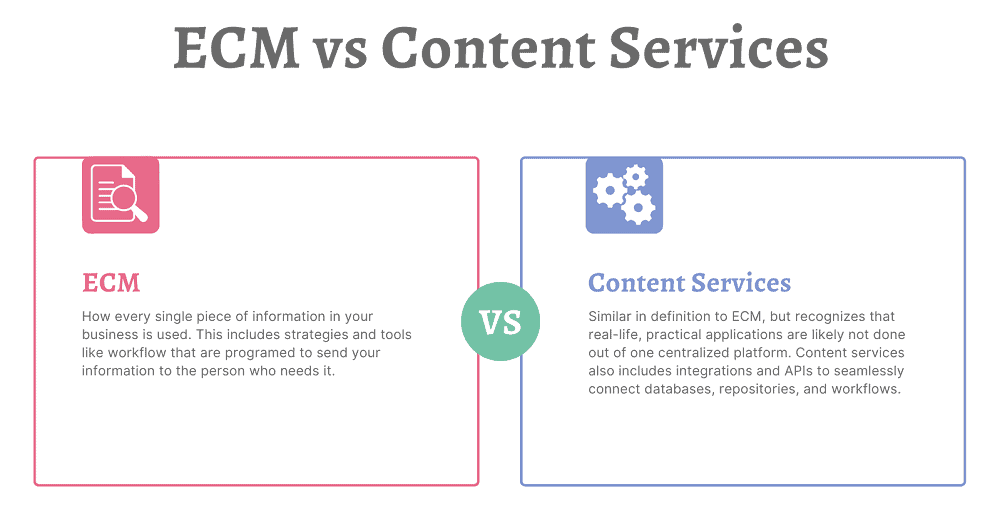
That being said, there are many platforms that aim to store, streamline, and automate your content that are also rich in integration opportunities. Those are called Content Services Platforms (CSPs).
What is a Content Services Platform?
According to Gartner, a content services platform is:
“a set of services and microservices, embodied as an integrated product suite and applications that share common APIs and repositories. A CSP exploits diverse content types and serves multiple constituencies and numerous use cases across an organization.”
 Essentially, a Content Services Platform is the next evolution of an enterprise content management system. It allows organizations to create, store, manage, and transfer information. A content services platform can include:
Essentially, a Content Services Platform is the next evolution of an enterprise content management system. It allows organizations to create, store, manage, and transfer information. A content services platform can include:
- Electronic forms
- Workflow automation
- Robotic (RPA) and other intelligent process automation
- Integrations with leading software (ERP, CRM, HRM, etc.)
Again, while CSPs are designed to be the main system of information management, they also feature the ability to be integrated into other software.
What Are the Different Elements of Content Services?
Content Services are broken into three main elements:
1. Content Services Platforms: the base platform that includes a content repository and acts as the main connector to other services. See above section for more details.
2. Content Services Applications: applications that provide business-focused solutions for functions like HR or IT. These can be separate or built into the content services platform. A good example is the Solution Marketplace for Laserfiche.
3. Content Services Components: components that provide a very specific function. This includes (but is not limited to) document imaging/data capture, electronic signatures, and language translation.
(click image to enlarge)
Why Do I Need a Content Services Platform?
One question that we hear a lot is: why do I need a content services platform when I can just store my files on our company servers or in general cloud storage?
The difference comes down to whether your files are living, active documents or just archival records.
If you’re storing archival records that rarely need to be accessed, then keeping them on your internal servers is a solution that will likely work well. As long as your network is secure, there shouldn’t be any problems with storing those records.
But companies that have lots of active, living documents that need to be accessed by multiple employees and/or departments can gain serious benefits by managing these files in a content services platform.
Benefits of a Content Services Platform
There are many benefits to investing in and using a content services platform.
Known Costs
Content services platforms will have upfront pricing based either on users or storage. There will be no surprises when your bill comes around and it’s easy to estimate costs if you need to scale up.
If you are using an online storage system (like Google Drive, OneDrive, Box, etc.), you can easily reach your free storage limit. We’ve had customers who reached that limit, but continued to upload documents, and were being billed without realizing it.
Records Retention
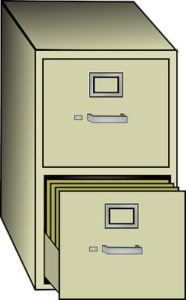 Often when it comes to records retention, companies just keep everything—just in case. But there’s no reason to. For example, most accounting-related information only needs to be kept for seven years (and depending on the document type, even less than that).
Often when it comes to records retention, companies just keep everything—just in case. But there’s no reason to. For example, most accounting-related information only needs to be kept for seven years (and depending on the document type, even less than that).
The problem with storing documents in a network folder is that you can’t assign searchable metadata to those files. So you either have to set up a very elaborate folder structure and hope that your employees stick to it, or manually search through the data to determine what can be deleted.
Content services platforms can automate all of this. Simply import documents, and the CSP can pull out relevant metadata (or you can add yourself), file the document in the correct folder, and tag it for a deletion report when it hits the end of its life. What may have taken hours or days manually will take minutes with a content services platform.
Standardized Filing
If you go into any organization, you will find that every employee names and files their documents a little differently.
With a content services platform, decision makers can determine a filing structure and then enforce it across the organization. Permission levels can be set to make it impossible for employees to change or modify the filing structure. This not only makes finding documents easier today but will make it easier for generations to come.
Accessibility
A paper file can only be in one place at a time (unless there are multiple printed copies and that can cause other issues). An electronic file on a server can likely only be accessed at the office (or via a VPN). Content services platforms are designed specifically so your employees can access them from anywhere. The leading services are cloud-based so employees simply need to log into a portal from a browser.
One thing we hear a lot is that organizations don’t require a CSP because they store all their documents as PDFs in their ERP or CRM system. Not only does this not allow them to be widely searchable, but it can potentially make it harder for employees to access the documents they need if they are not in a centralized repository.
Security
 Digital documents already have more security than paper ones, because people can’t just pick them up from a desk or pluck them from a filing cabinet.
Digital documents already have more security than paper ones, because people can’t just pick them up from a desk or pluck them from a filing cabinet.
But content services platforms take security even further. Administrators can assign special permissions to employees (either separately or as a group) so that they are only allowed to see the documents that they should and, if applicable, cannot delete anything from the repository. This means that only people processing invoices can see the Accounts Payable documents and only the highest level of Human Resources managers can see sensitive personal information.
These systems also feature document history and audit trails, so you know exactly who has opened and edited documents.
Additionally, CSPs feature some of the leading cybersecurity to keep your data safe and secure. Most also allow for two-factor authentication for organizations that want to add another layer of security.
Productivity and Time Savings
Being able to log into a document repository, make a search, and immediate find the information you need will allow your employees to work efficiently and service your customers (or students, or members, or whoever you need to provide information to) faster than ever before.
Additionally, process automation tools practically eliminate the time needed for basic tasks. When you’re working on paper, or even with digital documents, how long does it take you to get full and final approval? When you digitize and automate that process, you can reduce approval turnaround from days to minutes.
Ease of Use
 Content services platforms are designed for anyone to use. Like all new software, there is a learning curve, but once you get the basics down, you can quickly find whatever information you’re looking for. Folders and projects are simple to add documents to, which is essential for your active, living files.
Content services platforms are designed for anyone to use. Like all new software, there is a learning curve, but once you get the basics down, you can quickly find whatever information you’re looking for. Folders and projects are simple to add documents to, which is essential for your active, living files.
Most CSPs are built on folder or project structures, which means you can click down into the documents you need. Or you can do a text search and bring up all matching documents that you have access to.
CSPs are low- or no-code platforms, which means that advanced features like e-forms, workflow, and RPA (bots) are easy for people to setup without advanced coding knowledge.
Though for organizations with developers on staff, there is plenty of advanced functionality where you can design robust e-forms, workflows, and integrations. More about integrations in the next section.
Integrations
One of the most useful things about content services platforms is their ability to integrate with your other applications.
Think about the next time you hire an employee. With the click of a button, your HR management system can push information to your content services platform, which will in turn generate documents, inform relevant parties, email the onboarding forms, and kick off workflows for ordering equipment or creating user accounts on other systems.
Integrations are key for CSPs, and many of the leading platforms have native integrations with some of the leading accounting, HR, CRM, and ERP systems either right out of the box or easily added. There are also APIs and robotic process automation to connect the CSP to other disparate systems.
Now that we’ve covered some of the many benefits of a content services platform, let’s look at what you need to consider when selecting one for your business.
What Should I Consider When Shopping for a Content Services Platform?
There are a lot of CSPs, and each has their own strengths and weaknesses. However, you can find the right one for your business by doing some research.
 1. Determine which of your current systems are essential for business
1. Determine which of your current systems are essential for business
As in, make a list of the software that you use and want to keep using for your organization. This includes ERPs, HR and/or accounting software, CRMs, and other custom applications built and used in your business (commonly referred to as line of business or LOB applications). You’ll want to have this list ready to see if your prospective content services platform features any direct integrations or easily added connector software.
Running older programs that don’t generally have APIs or integrations? Not to worry – depending on what you use the software for, RPA can likely log in and perform basic tasks (e.g. data scraping, copy/pasting).
2. Think about what functions your organization will use now and how you would like to grow
While having all of your documents digitized in one centralized location is a great start to digital transformation, the real power of content services platforms is how you collect and use data. Think about what information you collect via paper forms and your processes around them. It’s likely that all of that can be digitized, and a lot of it can be automated, but you’ll need to make sure that your CSP has that capability.
 3. Partner with a consultant
3. Partner with a consultant
Because there are so many different content services platforms, we recommend finding a trusted consultant or partner who can match your company and its needs with the right software.
We recommend this because consultants are intimately acquainted with the software and can answer your questions, offer realistic recommendations, provide best practice scenarios, and determine what integrations or workflows you will need. They also work closely with the software companies, so they will know about new features coming up in the product development. Additionally, they have access to demo accounts so you can try systems for free before you commit.
In full disclosure: Datamation is a content services consultant, and we would love to work with any company on their digital transformation journey!
4. Start your research
If you prefer to handle your project internally, then it’s time to do some research. Armed with your notes from steps one and two, it’s time to start diving into systems.
Start by going to software review websites to see how experts and customers rank their systems. Some great places to start are:
Remember: Enterprise content management systems and document management systems can also be content services platforms.
Pay extra attention to platforms listed as customers’ choice—these are ranked by actual users of the platform and not the website review team. It’s good to know how actual users feel because it doesn’t matter how cool a system looks, or how many features it boasts, if your employees don’t use it. It is not worth your investment.
Make a list of 5-10 content services platforms that you would like to research further and then go to their websites. The software websites will show you top features more in-depth and should have a listing of their integrations.
From there, you should be able to narrow down your list to 2-3 platforms. This is when you would request information from the sales team or setup a demo account. When you have demo accounts, make sure to use actual files from your organization so you can test how you and others would interact with the platform.
After gathering more information and/or trying the demo accounts, the right CSP for you should be obvious. But if you’re still unsure, consider looking for that right consultant or partner for more guidance!
There’s a lot to content services, so if you want to review a section, here are the quick links again:
- What are Content Services?
- What is the Difference between Content Services and ECM?
- What is a Content Services Platform?
- What Are the Different Elements of Content Services?
- Why Do I Need a Content Services Platform?
- What Should I Consider When Shopping for a Content Services Platform?
Thinking about a new content services platform for your organization? We’d love to help you find the right one for your business. Contact us or give us a call at (630) 321-0601.
Questions or comments on this article? Find us on LinkedIn or Twitter.
